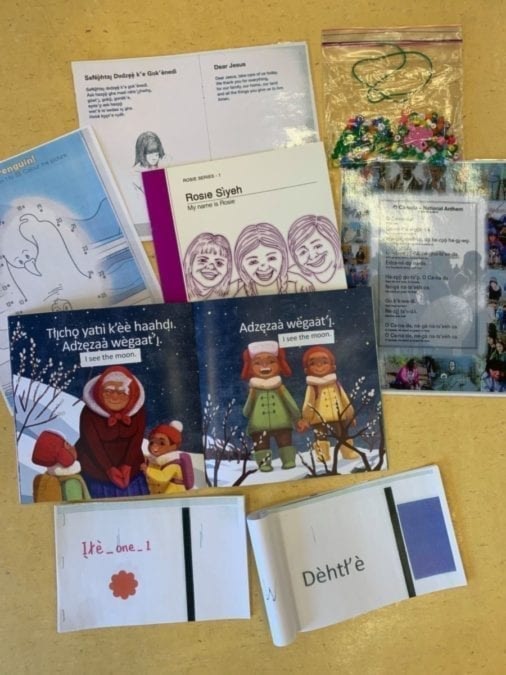Two weeks after education in the NWT was shifted out of the classroom because of the Covid-19 pandemic, the forms that online and paper-based education are now taking differ from school to school across the territory.
School board leaders and the Minister of Education reached an agreement on March 25 to close schools for the remainder of the 2019-2020 school year as a safety measure against the spread of coronavirus. Remote learning began on April 14.
RELATED REPORTING: NWT education leaders in agreement on 2019-2020 school closures
RELATED REPORTING: Students return to virtual classrooms
Yellowknife's Weledeh Catholic School has linked almost 80 per cent of its students to online learning, said principal Jenny Reid.

photo courtesy of Catherine Son
“We're trying to keep the amount of paper (learning) packages we deliver to a minimum for health precaution reasons,” she said.
Weledeh has helped more families get online by lending out Chromebook laptops, of which more than 50 were handed out by Monday.
There are, however, about 10 per cent of families who aren’t connected to paper or online learning because Weledeh has been unable to reach them through electronic means or by phone.
“Our counsellors are scheduling home visits to check on them,” Reid said.
For Grade 5 and 6 teacher Catherine Son, most of her 30 students connect to her classes online using Google Meet. The students who don’t have computer access at home receive the paper packages and Son follows up on the lessons with them via phone calls or texting.
Adapting curriculum to online format
The experience of teaching remotely has so far been very different for Son. In line with the education mandate from the Department of Education, Culture and Employment, she teaches only five hours a week and her lessons focus on literacy and numeracy.
“I’m still trying to provide lessons that are engaging and hands-on as best I can,” she said.
The changed curriculum for remote learning means that some subjects like religion and second languages haven’t been part of her day-to-day lessons, but she plans to gradually expand her teaching scope.
“I’ve been trying to integrate health and wellness so far for this past week. As time goes on I want to integrate some health and wellness and activities that would integrate science and social studies into their literacy and numeracy activities and integrate their families so they feel supported in what they do,” she said.
Her students aren’t the only ones learning. Son finds that every week she discovers new online teaching tools or new methods for presenting her materials through Google Meet.
The main challenges she has faced with the new learning system are technological, such as the internet not streaming properly or students sometimes struggling to open documents.
Making remote connections
While Son is separated by distance from her students, and said “nothing replaces the classroom,” she’s in as much contact with her students and their families as she ever was.
“I’m more in tune with how my students and their families are doing because I keep in such close contact with them...I try to make myself available to them everyday so if they have questions or concerns they can access me just as they could at school.”
All online at Sissons
At J.H. Sissons, the school has managed to connect all of its students to online classes. Families who didn’t have adequate computer or internet access at home borrowed have Chromebooks from the school.
“We lent out 35 Chromebooks. We originally planned to lend out 20-25. We've received additional requests for Chromebooks as people start to get a sense for what managing learning at home will require, especially for families with more than one child,” said principal Graham Arts.
But the new reality of learning has brought some difficulties, he explained.
“Some parents are adapting to how the learning program works because they have to understand how the websites and software work, and they also have to manage having the kids at home. It's fair to say that some people are challenged by that," he said. "That's completely understandable if you have kids learning at home and adults working from home.”
An array of methods in the Tlicho
In the Tlicho region, roughly half of the families are connected to the remote education online and half are doing paper-based assignments through the five schools operated by the Tlicho Community Services Agency (TCSA), said Linsey Hope, director of education.

photo courtesy of Facebook
The high school students are mostly using the Moodle program to connect with classes. Because of limited internet connectivity in the Tlicho region, the TCSA is deploying various supportive technologies for the education such as WiFi ‘hot spots’ at schools where students can drive up and connect to receive or submit assignments, borrow laptops, exchange USB sticks, post assignments on social media and over the radio and communicate by phone.
Hope said specific data on how many families are using each type of supportive technology wasn’t yet available but added that as more feedback is received the system will be improved.
Paper packages are commonly left at pick-up spots such as the school, community government or post office.
Keeping the language strong
Like other schools across the NWT, the education curriculum for the Tlicho region focuses on literacy and numeracy and its Tlicho language immersion programs at Elizabeth Mackenzie Elementary School in Behchoko are continuing as usual.
RELATED REPORTING: Talking about the future of teaching Indigenous languages
“Similar to other immersion programs (like French) the language of instruction remains in the language used in the class,” said Hope.
“Our immersion teachers are providing work in Tlicho and working with parents to support those with limited Tlicho. As with other districts across the North, our specialist teachers are working with core classroom teachers to supplement learning packages with Tlicho, physical health and other speciality courses. We pride ourselves on providing integrated activities that bring families together and honour the Tlicho history, language, and culture.”
